Staying ahead of the competition in dropshipping means continually discovering winning products before everyone else. But how can you predict what shoppers will want next? Google Trends offers a data-driven answer. By analyzing what people are searching for on Google in real time, you can uncover emerging product opportunities and gauge demand before investing in inventory. We'll explore how to leverage Google Trends for dropshipping success – from understanding seasonal patterns and regional preferences to sourcing suppliers and converting search interest into actual sales.
Whether you're seeking your next bestseller or trying to validate a niche, Google Trends can shine a spotlight on consumer demand and help you stock your store with products people are actively looking for. Let's dive into how it works and how you can use it to find the best dropshipping products.
What is Google Trends & Why it Matters for Dropshipping?
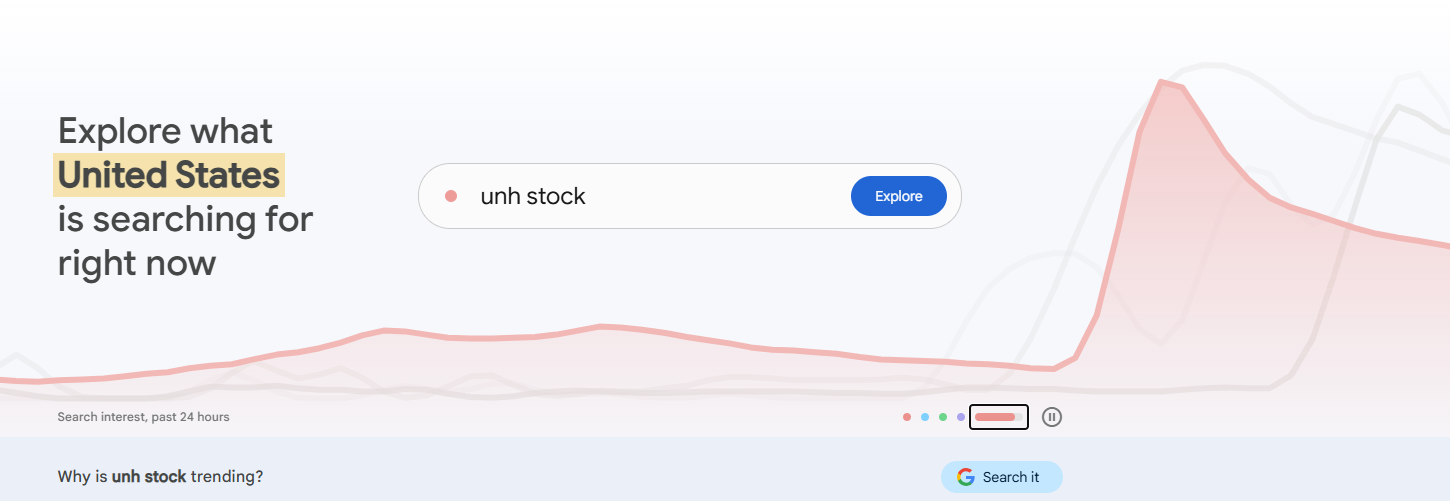
Google Trends is a free tool that shows how often people search for specific terms on Google, visualizing popularity over time. In essence, it’s “a window into real-time consumer demand,” revealing what shoppers around the world are interested in at any given moment. For a dropshipping business, this insight is invaluable. It allows you to spot rising product trends, check seasonal demand, and identify emerging niches before your competition catches on.
In the dropshipping model – where you typically don't manufacture products yourself – choosing the right product to sell is half the battle. Google Trends helps ensure you’re selling something people actually want. After all, if you start selling a product that nobody’s interested in, you’ll be fighting an uphill battle to make any sales. By using Google Trends to confirm there is sufficient search interest (and therefore consumer interest) in a product, you can make data-backed decisions about which products to add to your store. In short, Google Trends matters for dropshipping because it takes the guesswork out of product research and lets you align your offerings with genuine customer demand.
How to Find Trending Dropshipping Products Using Google Trends
Google Trends isn’t just a curiosity tool – it’s a powerful ally in product research when used effectively. To find trending dropshipping products with Google Trends, follow these steps and tips:
1.Start broad and refine: Begin by entering a broad product category or niche keyword into Google Trends Explore and setting an appropriate time frame. For a big-picture view, look at the past 5 years of data; this shows long-term interest patterns and growth. You can also adjust to shorter periods (12 months, 90 days, etc.) to zoom in on recent surges. Narrow down by category or type of search (e.g. Web Search, YouTube, Shopping) if needed to get more relevant product insights. This initial survey will highlight broad trends in your niche.
2.Analyze interest over time: Examine the Interest Over Time graph for each term. You’re looking for products with a steady or growing search trend, not just a one-hit wonder spike. A product that shows a gradual, consistent climb in interest (with maybe some ups and downs) is a better bet than one that spiked due to a short-lived fad and then crashed. For example, if “desk lamps” had one huge spike due to a viral TikTok but flatlined afterward, it’s risky – whereas a term like “LED home lighting” with slow, continuous growth is more promising. Consistent or rising interest indicates organic demand that could translate into sustainable sales.

3.Use Related Queries to spot specific product ideas: Scroll down to the Related Queries or Related Topics section for your search term. Here, Google Trends lists search terms that people commonly look for in relation to your product – including those with rising popularity. These can reveal niche product opportunities or sub-trends within a category. For instance, if you search for “sunscreen” and see related queries like “mineral sunscreen” or “sunscreen for oily skin” climbing in popularity, that hints at specific products or features people want. In dropshipping, these nuanced insights can lead you to stock exactly the variant that is trending (such as tinted sunscreen or reef-safe sunscreen in this case). Keep an eye out for any query marked “Rising” or “Breakout,” which signals a surging interest in a very recent term – potentially an early indicator of a hot new product or trend.
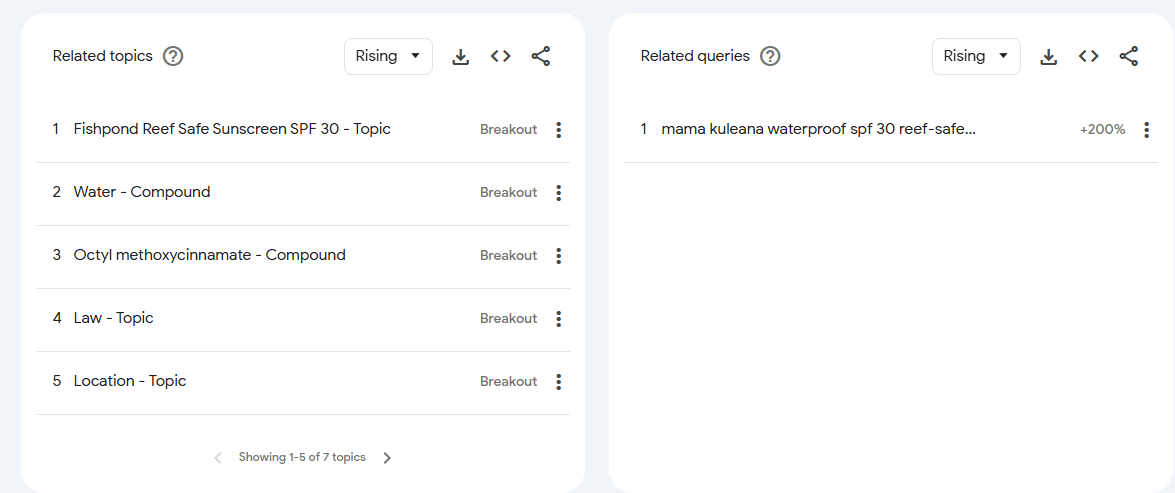
4.Compare similar search terms: If you have multiple product ideas or variations, use Google Trends’ compare feature to pit them against each other. For example, you might compare “wireless earbuds” vs. “Bluetooth earphones” vs. “true wireless headphones” to see which term has higher relative interest and how their trends differ. This helps you identify which product (or even which naming convention) is more popular with consumers. It also teaches you the language your customers use: Google Trends can show if people search more for “skincare fridge” versus “beauty fridge,” for example, which is invaluable for optimizing your product titles and descriptions with the right keywords. By comparing terms, you ensure you’re focusing on the product with greater demand and using the vocabulary that resonates with your audience.

5.Identify seasonal patterns: Many products aren’t equally popular year-round – they have seasonality. Google Trends makes it easy to detect these patterns. Look at multi-year data and note if the search interest jumps during certain months each year. For example, a search for “lunchbox” will show recurring spikes every August, coinciding with back-to-school season. A term like “ugly Christmas sweater” will naturally peak every December and be almost dormant in summer. Recognizing these cycles allows you to time your marketing and inventory. If you see that “beachwear” queries consistently surge in late spring, you should start promoting swimwear and summer apparel in April and May, so your store is ready when demand hits its peak. (We’ll dive deeper into seasonal trend analysis in a later section.)

6.Filter by location to find regional trends: If your dropshipping store targets specific countries or regions, always check how interest varies geographically. Google Trends can break down search interest by country, state, or even metro area. A product might be trending upward globally but could have especially high interest in, say, Australia or California. By switching the location filter to your target market, you ensure the trend is relevant to your customers. Sometimes you’ll discover a product is hugely popular in one region but not yet in another – which presents an opportunity. For instance, if “electric bikes” are trending in Europe but barely searched in Latin America, a savvy seller might introduce them to the under-served market early. Understanding where a product is hot helps you tailor your advertising and even choose warehouse locations for faster shipping. (We’ll discuss location-specific product research more later on.)
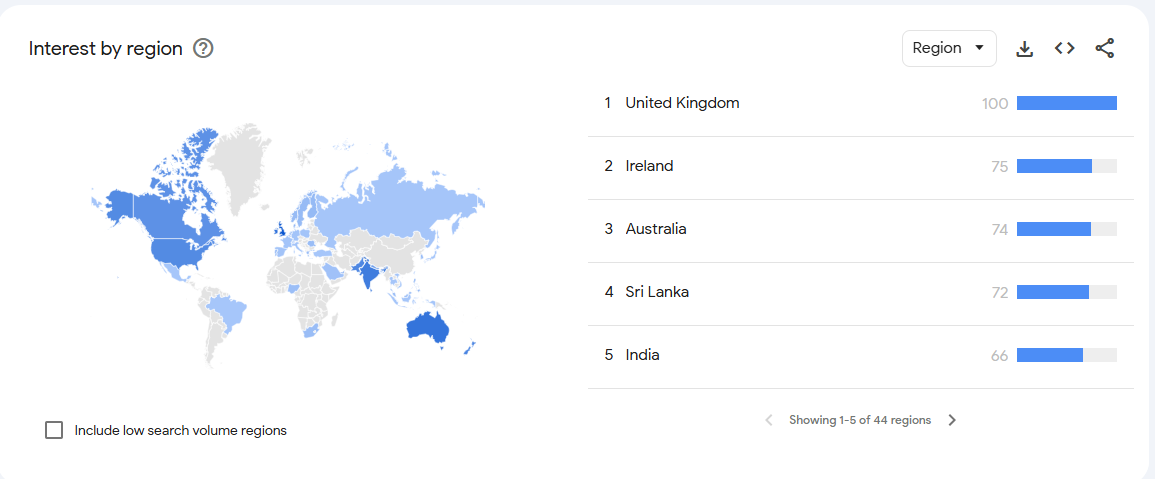
7.Watch for breakout terms and emerging niches: The Trending Searches section on Google Trends (and the “Rising” filter in related queries) are goldmines for finding brand-new trends. “Breakout” indicates a term surged by over 5000%, often because it’s a new or viral topic. For dropshippers, catching a breakout search term early – say a sudden craze for “fidget rings” or “AI-powered dog toys” – can mean getting in on a hot product before the market is saturated. Make it a habit to browse the daily or real-time trending searches, especially in categories relevant to your niche, to spark ideas for products that are on the uptick.
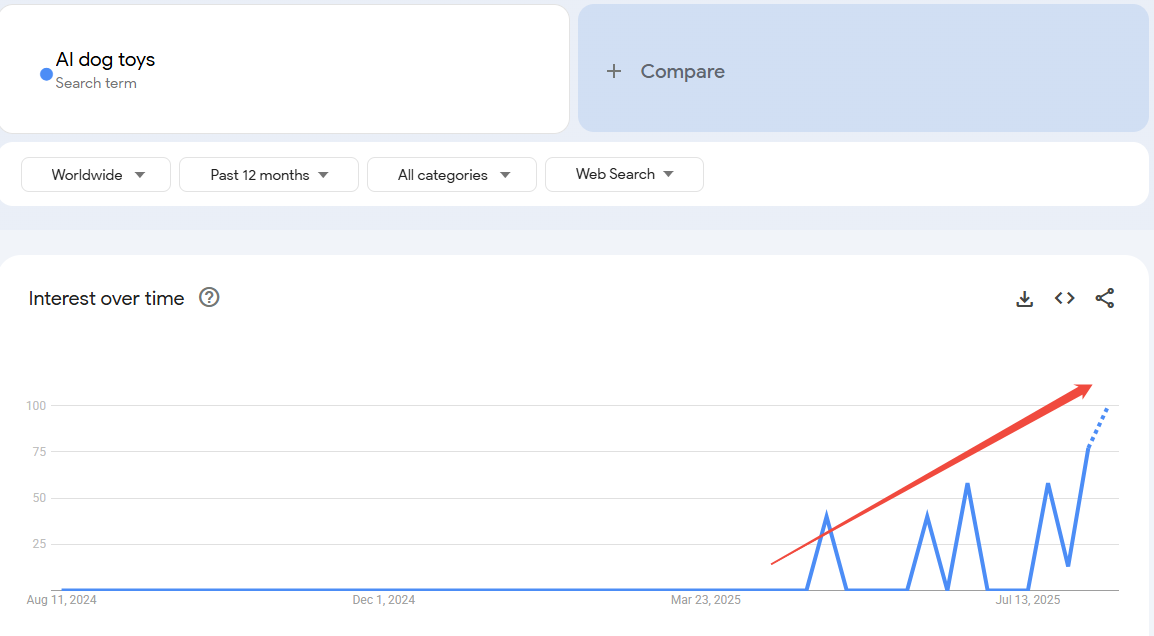
8.Validate the trend with external research: A crucial final step – just because something is trending in searches doesn’t guarantee it will convert to sales (or that you should sell it). Some search trends might be driven by curiosity or news, not purchase intent. For example, millions might search a celebrity name or a meme, but that doesn’t mean there’s a product to sell. So, before you fully commit to adding a “trending” item to your store, validate its market viability. Check if the product is available and selling well on marketplaces like Amazon, eBay, or AliExpress. Look at the number of competitors: if dozens of sellers already offer the item, you might face an uphill battle unless you differentiate. On the other hand, zero competitors with high search interest could indicate a gap you can fill – or a sign the trend hasn’t translated to a product yet. Additionally, scan social media (TikTok, Instagram, Pinterest) to see if the trend is part of a broader consumer craze or just a niche discussion. If possible, get feedback from your target audience (polls, forums, etc.) to see if they’d actually buy the product that’s trending in Google searches. This due diligence will save you from chasing every spike and focus on trends that have real commercial potential.
By following these steps – from digging into the data to cross-validating with real-world demand – you can confidently use Google Trends to find dropshipping products that are not only trending online but also primed to sell. In the next sections, we’ll look at some current trending product examples and deeper analyses of seasonality and regional interest to further sharpen your Google Trends research skills.
Top 8 Google Trends Dropshipping Products
Using the above methods, let's highlight some specific products and niches that Google Trends data shows as promising for dropshippers. These examples combine rising search volume and consumer interest as of 2024–2025, indicating they could be winning products for your store. Here are 8 trending products (and niches) identified via Google Trends:
1. Portable Blender
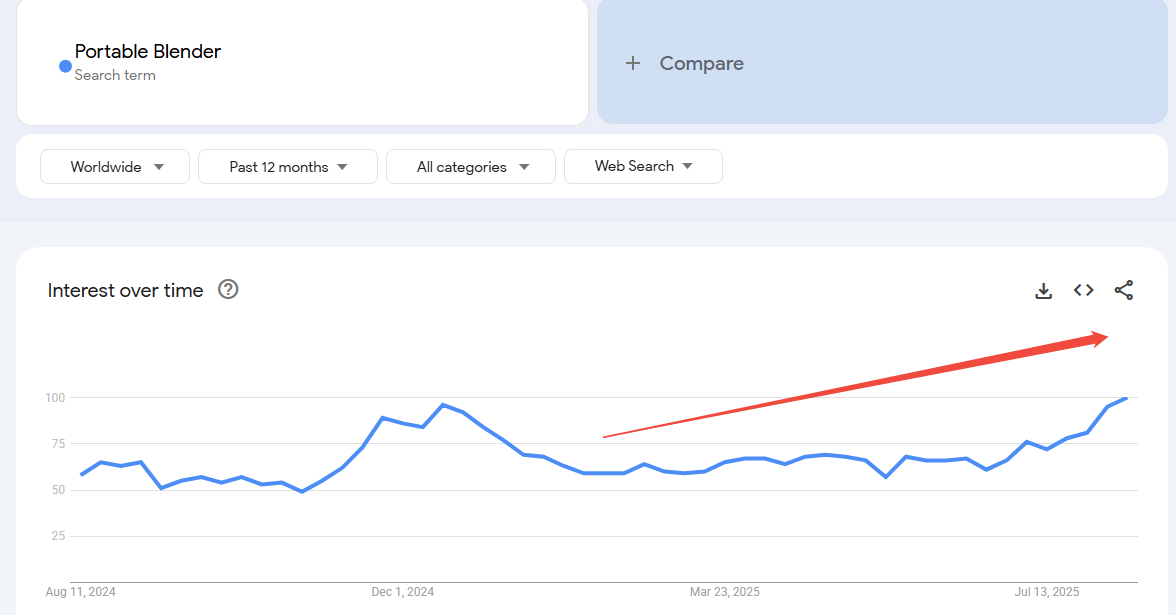
Why It Sells – The portable blender taps into the booming health and fitness trend, especially among young professionals and students who want smoothies or protein shakes on the go. Social media influencers love showing quick recipes, driving impulsive purchases.
Trend Factor – Google Trends shows strong seasonal spikes in January (New Year resolutions) and early summer.
Profit Tip – Add value bundles like smoothie recipe eBooks or reusable straws to increase perceived value.
Sourcing Tip – Source from suppliers offering BPA-free, rechargeable models with multiple speed settings.
Store Strategy Tip – Target Instagram Reels and TikTok audiences with “15-second smoothie” content to trigger viral shares.
2. LED Strip Lights

Why It Sells – The rise of gaming setups, home mood lighting, and DIY décor has made LED strip lights a lifestyle product rather than just home hardware. Perfect for Gen Z and Millennials decorating small spaces.
Trend Factor – Google Trends shows two annual peaks: back-to-school season and November–December holiday décor rush.
Profit Tip – Offer multi-length bundles to increase average order value and reduce shipping costs per unit.
Sourcing Tip – Choose suppliers providing app-controlled RGB lights compatible with smart home devices.
Store Strategy Tip – Run video ads showing quick transformations of rooms using time-lapse effects.
3. Reusable Water Bottles

Why It Sells – Environmental awareness and sustainable living push consumers toward reusable bottles over single-use plastics. The category benefits from both eco-conscious buyers and lifestyle branding potential.
Trend Factor – Interest is steady year-round with slight spikes during warmer months.
Profit Tip – Use personalization or custom prints to justify higher margins.
Sourcing Tip – Select suppliers offering stainless steel, BPA-free materials with good insulation performance.
Store Strategy Tip – Collaborate with micro-influencers in fitness, hiking, and yoga niches.
4. Pet Grooming Gloves

Why It Sells – Pet owners seek easy, low-mess grooming tools that feel like play for their pets. These gloves are affordable, lightweight, and visually satisfying to demonstrate.
Trend Factor – Peaks during shedding seasons (spring and fall) in most countries.
Profit Tip – Bundle two gloves or pair with a grooming brush to encourage upsells.
Sourcing Tip – Work with suppliers that use durable, soft silicone tips to avoid pet discomfort.
Store Strategy Tip – Share before-and-after grooming videos for maximum engagement.
5. Phone Tripods
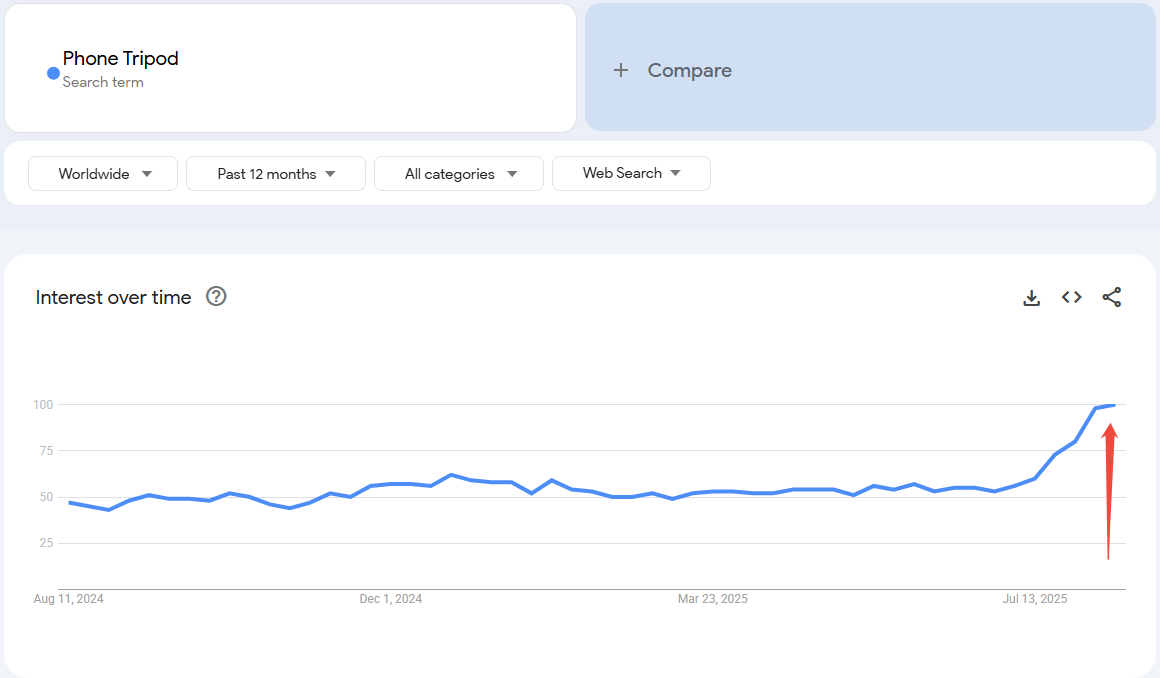
Why It Sells – With TikTok, Instagram, and YouTube Shorts booming, affordable filming accessories are in constant demand. Phone tripods appeal to both casual content creators and professionals.
Trend Factor – Search spikes appear in Q4 (holiday gifting) and back-to-school months.
Profit Tip – Offer combo kits with tripod, ring light, and remote control to raise margins.
Sourcing Tip – Choose lightweight, collapsible models with universal phone mounts.
Store Strategy Tip – Partner with creators for product demos showing easy filming setups.
6. Car Seat Gap Organizer

Why It Sells – Drivers often struggle with small items like phones, coins, and cards slipping between seats. This organizer solves a daily frustration while adding extra storage space. It appeals to both everyday commuters and road-trip travelers.
Trend Factor – Google Trends data shows small peaks in spring and during holiday shopping season, with a noticeable rise before summer road trip months.
Profit Tip – Offer pairs to boost average order value and lower per-unit shipping costs.
Sourcing Tip – Choose durable leather or high-quality ABS models that fit most car models.
Store Strategy Tip – Use video ads showing “before vs. after” scenarios to highlight its convenience.
7. Resistance Bands
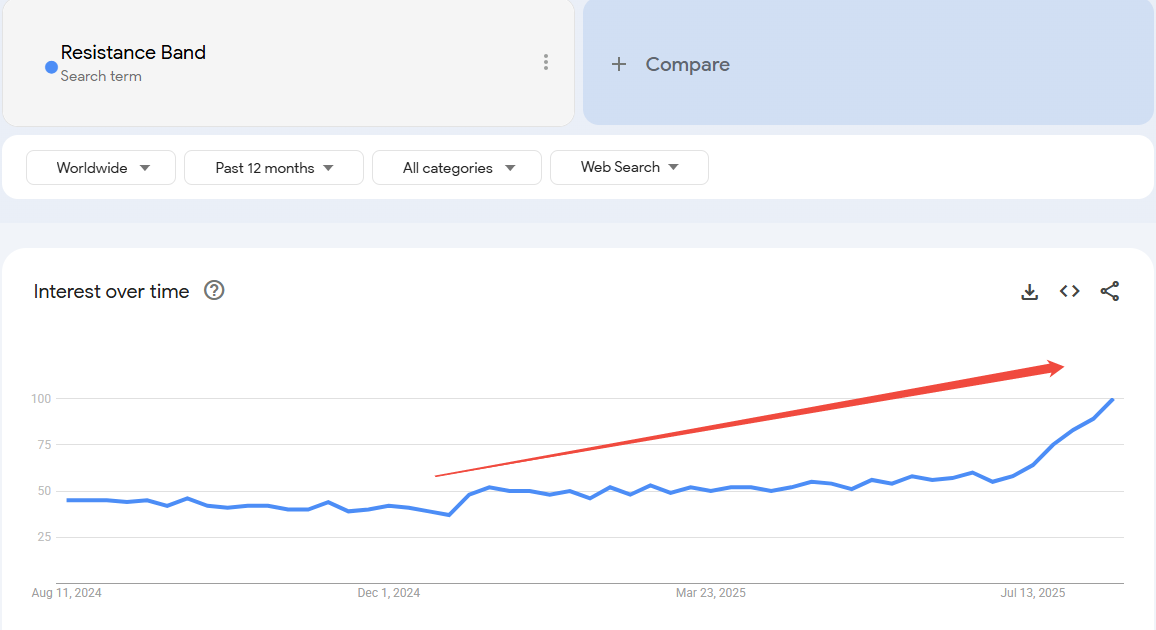
Why It Sells – Home fitness remains strong, and resistance bands are lightweight, affordable, and space-efficient. They suit beginners, experienced athletes, and even physical therapy users.
Trend Factor – Demand spikes in January (New Year’s fitness resolutions) and again before summer.
Profit Tip – Sell multi-strength sets to justify higher pricing and encourage repeat orders.
Sourcing Tip – Source natural latex bands with high durability, including storage pouches and instructional guides.
Store Strategy Tip – Collaborate with fitness influencers to create short workout tutorials.
8. Wireless Car Vacuum Cleaner
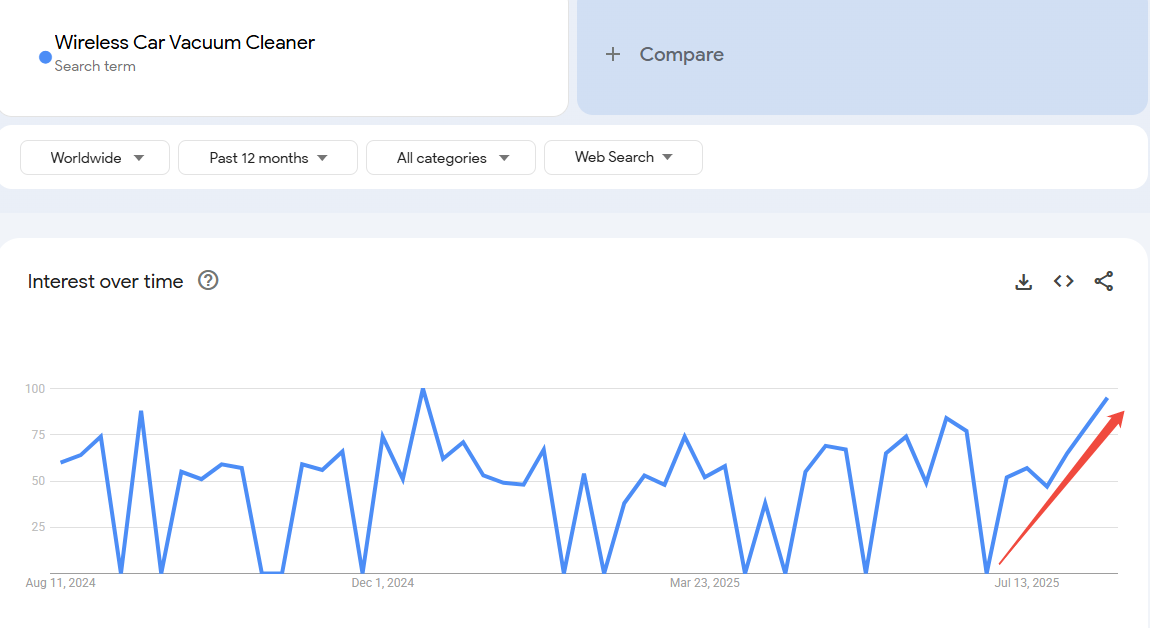
Why It Sells – Car owners are increasingly attentive to interior cleanliness, and a wireless vacuum is compact, convenient, and perfect for quick cleanups. It’s also a popular practical gift item.
Trend Factor – Searches rise in spring and autumn (seasonal cleaning) and peak again during year-end gifting season.
Profit Tip – Position the product as a mid-range or premium option based on suction power and battery life.
Sourcing Tip – Choose lightweight, low-noise models with multiple nozzle attachments for different cleaning needs.
Store Strategy Tip – Feature before-and-after cleaning videos, focusing on hard-to-reach spots like seat gaps and cup holders.
Seasonal Dropshipping Products Analysis with Google Trends
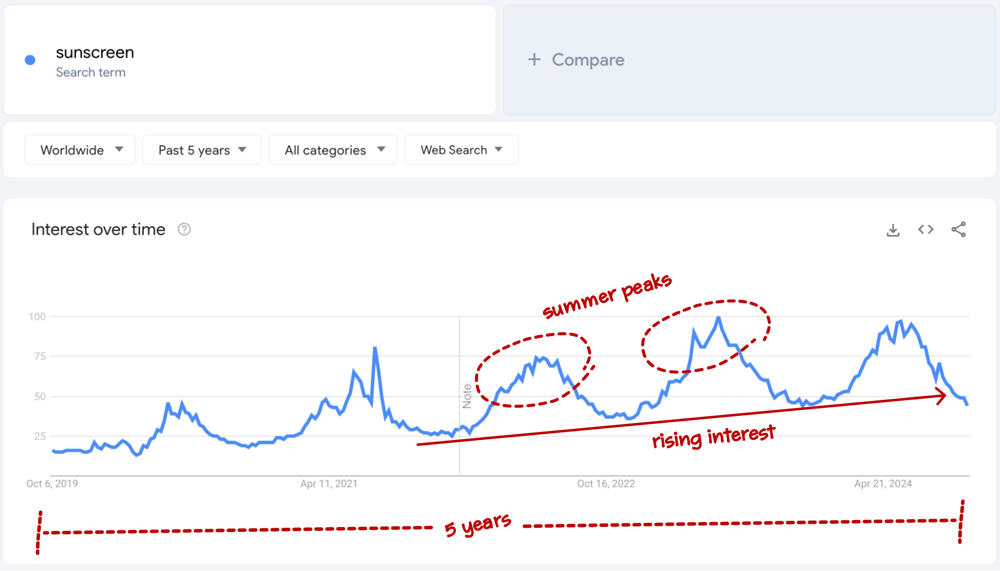
Google Trends interest over time for “sunscreen” (Worldwide, 5-year span). The graph shows clear seasonal peaks every summer (dotted red circles) and an overall rising interest trend (red line) for sunscreen. Such data helps dropshippers anticipate when demand will spike and grow year-over-year, so they can time their inventory and marketing for seasonal products.
Seasonality plays a huge role in product demand. Some products explode in popularity during certain times of the year and then taper off. Google Trends is an ideal tool for visualizing these seasonal patterns so you can prepare accordingly. In the embedded graph above, for instance, you can see that interest in “sunscreen” hits its peak each year in May-June (as summer begins in the Northern Hemisphere) and dips to its lowest in winter. Importantly, the baseline interest is rising each year (the lows are higher than they were a few years ago), meaning sunscreen as a category is growing overall, even though it’s seasonal. This kind of insight – a seasonal wave on an upward trajectory – is golden for planning a dropshipping business.
Here are some tips on analyzing and leveraging seasonal trends with Google Trends:
-
Identify recurring peaks and troughs: Look at at least 2-5 years of data for your product keyword. Do you see a spike every year around the same month? If yes, that’s a reliable seasonal pattern. For example, Google Trends shows searches for “lunchbox” reliably surge in August, right before the school year starts. Similarly, terms like “ski jacket” will spike in winter, and “patio furniture” will spike in spring. Once you identify when the interest spikes, you can work backward to schedule your campaigns and stock. Tip: Many experienced dropshippers begin advertising seasonal products about 4-8 weeks before the expected peak. That way, they capture early shoppers and build search engine presence by the time most customers are buying.
-
Use year-over-year comparison: Google Trends lets you adjust date ranges and even compare multiple time periods. A clever technique is to compare the same seasonal window across different years (e.g., Nov-Dec 2023 vs Nov-Dec 2024) to see if the interest is higher this year than last. If a seasonal product is gaining more interest each year, that indicates a growing trend (like in the sunscreen example, each summer peak higher than the last). If it’s declining, that seasonal product might be falling out of favor. By doing a year-over-year analysis, you can prioritize products that are not just seasonal, but also on an upward trend overall.
-
Notice event-driven spikes: Not all seasonal surges are due to weather or holidays; some relate to events or trends. For instance, “World Cup jersey” searches will spike during the soccer World Cup (which is seasonal in the sense of occurring every four years), or “Oscars dress” might spike around the Oscars night as people look up celebrity fashion. If your niche has such events (sports, cultural events, annual shopping holidays like Black Friday), factor those in. Google Trends can show interest around those events, helping you prepare limited-time product lines or marketing pushes.
-
Plan inventory and marketing around the cycle: Once you know the pattern, align your operations to it. Inventory planning is crucial – if you dropship from suppliers, make sure they have enough stock when the spike hits (nothing’s worse than having orders you can’t fulfill during the peak). If possible, communicate with suppliers ahead of a season to ensure smooth supply. Marketing-wise, ramp up your SEO content a month or two before the season (because SEO takes time to yield traffic). For example, publish blog posts like “Top 10 Beach Accessories for Summer” in early spring, rich in keywords that will trend, so that by summer your site ranks well. For paid ads, you might increase your budget as the peak approaches, then taper off to avoid wasting money in the off-season.
-
Supplement seasonal with evergreen: A caution for dropshippers – having only seasonal products can lead to feast-and-famine sales cycles. One way to mitigate this is to also carry some evergreen products (that sell consistently all year) to keep cash flow stable. Google Trends can help here by identifying products with relatively flat interest year-round (no big spikes or dips). That said, seasonal products can be fantastic profit generators; just be ready for the off-season. Some businesses even launch seasonal stores (for example, a store that primarily sells Halloween costumes will make most of its revenue in Aug-Oct and be quiet the rest of the year). If you go that route, you might plan to run multiple seasonal niches to balance the calendar (e.g., a summer store and a winter holiday store under one umbrella brand).
-
Leverage Google Trends’ comparison for seasons: The tool has a compare feature – you can compare interest in “grill accessories” in Summer vs Winter, or even compare two seasonal products (like “air conditioner cover” vs “space heater”) to see which has higher peaks. This can inform which product is a bigger opportunity. Maybe you find that interest in “pool floats” is double the interest in “ski goggles” – that tells you the summer pool niche might have a larger market than winter sports, influencing your focus.
Google Trends essentially acts as a radar for seasonal demand. By regularly checking it, you won’t be caught off guard by, say, a sudden Easter-related trend in March or the spike in gym equipment every January (New Year’s resolutions). Instead, you’ll see it coming and can prepare your dropshipping store’s promotions, ads, and stock to meet customers exactly when (and where) they’re searching.
Finding Location-Specific Winning Products
One of the most powerful yet sometimes overlooked features of Google Trends for product research is its geographical data. Trends can vary not just by time, but by location. What’s trending in one country (or even one state or city) might not be in another – and that represents both opportunities and insights for a dropshipper.
Google Trends provides an “Interest by region” breakdown for any search term, showing which locations have the highest relative search interest. Here’s how you can use this to find location-specific winning products and refine your marketing:
-
Discover where demand is highest: When you search a product on Google Trends, scroll to the map and see which regions light up. For instance, imagine you search for “organic coffee beans” and see that interest is highest in say, Hawaii, California, and Colorado in the US. That tells you those states have a disproportionate interest in organic coffee (perhaps due to local culture or demographics). If you’re running ads, you might focus your budget on those states to get a better ROI, since people there are actively searching. In fact, knowing which cities search most for your product can let you target very precisely – Google Trends might show that “self-tanner” is extremely popular in certain sunny cities. You could then geo-target those cities with ads for self-tanning products. By concentrating efforts where demand is highest, you spend marketing dollars more efficiently.
-
Identify regional niches: Sometimes, a product might not be universally popular, but in a certain region it’s a hit. For example, suppose “heated blankets” search interest is huge in Northern climates but low in the tropics (makes sense). If you operate in multiple markets, you could push heated blankets in Canada during winter, but not bother promoting them in Florida. Or you might find a product that’s a cultural trend in one country – e.g., K-pop merchandise is highly searched in Southeast Asia and South America. If you saw that on Trends, you might stock more K-pop related items for those regions’ customers. Another example: via Google Trends you notice that “hiking backpack” is trending in Colorado more than other states – perhaps due to local lifestyle – so an online outdoor gear store could run Colorado-specific promotions or content (like “Best Hiking Backpacks for Colorado Trails”). In short, regional data can reveal micro-opportunities that a nationwide average would blur out.
-
Spot emerging markets: This is a clever use-case – if something is trending in one country but hasn’t caught on elsewhere, it might spread soon (globalization of trends). For instance, a certain tech gadget could be huge in South Korea and just starting to appear in US searches. If you catch that early, you could be one of the first to offer it in the US. Google Trends helps by allowing country-specific filtering. Let’s say you see that electric scooters became a big trend in Europe last year (with search spikes in Europe), and now US interest is picking up this year. That could indicate the US is a bit behind the curve, but following the same path – a chance to jump in early in the US market. Another angle: use the compare feature to compare a term in two regions. If “smart home energy monitor” is trending upward in the UK but flat in the US, that might be a product to introduce stateside, banking on the possibility that Americans will catch on next. As CJdropshipping experts put it, if a product is booming in one state or country and barely known elsewhere, there’s a window to target untapped regions before competitors move in.
-
Tailor inventory to regional preferences: If you serve multiple countries (or plan to), use Trends to understand local preferences. For example, the same type of product might have different variants popular in different areas. Perhaps “green tea flavor protein powder” is all the rage in Asia, while “chocolate flavor protein powder” dominates in the USA. Or color preferences: maybe Europeans search more for “black-out curtains blue” while Australians search “black-out curtains grey.” These nuances can guide which variants of a product you stock for each market. It’s almost like doing market research at a granular level without leaving your desk. BrandsGateway noted that if your business serves specific regions, Google Trends can show if certain products are more popular in one area vs another, letting you tailor your advertising and inventory accordingly. This could even affect warehousing – if you know Product X sells mostly in the Northeast U.S., you might stock it in a New York warehouse (for faster shipping to that area) rather than in L.A.
-
Understand cultural and seasonal differences by region: Don’t forget that seasons are opposite in the Northern vs Southern Hemisphere – Google Trends data by country will reflect that. For example, Australia’s search interest for “sunscreen” will peak around December-January (their summer) whereas the US peaks in June (our summer). If you target both hemispheres via global shipping, you can essentially have two seasons of certain products. As another cultural example, certain holidays are regional – “Diwali decorations” will trend in India but not elsewhere; “Singles’ Day sale” (a big November shopping day) trends in China. By using location filters for these terms, you can pinpoint when and where to promote relevant products.
In practice, to use Google Trends for location insights, enter your term, then set the location filter (or just view the default map for worldwide). Click on specific countries to drill down, or even states for big countries like the US. Google even allows city-level data for some searches, which can be eye-opening for local targeting. Combining this with your advertising tools can yield a highly optimized campaign – for example, running Facebook or Google Ads only in the top 5 regions where search interest is highest, thus capturing the “low-hanging fruit” of demand.
In summary, location-specific trend analysis helps you sell the right product to the right people. It prevents you from a one-size-fits-all approach in markets where one size definitely does not fit all. By aligning your product selection and marketing with regional demand signals, you increase the chances of a product becoming a winner in that market (and avoid trying to sell snow shovels to Hawaiians, so to speak).
Sourcing Suppliers for Google Trends Dropshipping Products
Identifying a trending product is only half the battle – you also need to source it reliably and at a good cost to capitalize on the opportunity. In dropshipping, your suppliers are your lifeline. A great product trend can turn into a nightmare if your supplier runs out of stock, ships too slowly, or has poor quality. So, once Google Trends has helped you spot a product you want to sell, the next step is finding the right supplier for it. Here are several routes and tips for sourcing trending dropshipping products:
-
Online Marketplaces (AliExpress, 1688, etc.): The go-to option for many dropshippers is platforms like AliExpress, Alibaba’s 1688.com (for Chinese domestic prices), or even Amazon/eBay for some items. These marketplaces have thousands of suppliers and products, so chances are you’ll find the trending item there. The advantage is the huge variety and the ability to start with small orders (even single-unit dropshipping) to test the market. If you find, say, that “portable blender” is trending up on Google Trends, a quick AliExpress search will reveal dozens of listings for portable blenders. Look for suppliers with high ratings, good customer feedback, and many orders fulfilled – this usually indicates reliability. Be mindful of quality differences and shipping speeds on these marketplaces. Two suppliers might sell identical-looking blenders, but one uses a better battery or motor. Always check reviews and if possible order a sample for yourself to verify quality. Also note shipping: some AliExpress suppliers ship from China only (which could mean 2-4 week delivery), while others have local warehouses (US, EU) for faster shipping. Use filters and read shipping options carefully. Marketplaces are ideal for quick initial sourcing to catch a trend early, but if the product takes off, you might later switch to a more specialized supplier for consistency.
-
Specialized Dropshipping Platforms: Platforms like CJ Dropshipping, Zendrop, or Modalyst integrate directly with your store and often provide end-to-end service (product sourcing, quality check, and fulfillment). These can simplify the process for trending products. For example, CJ Dropshipping allows you to post a sourcing request – if you see a breakout trend, you can ask them to find that product for you, and they often will list it if they can source it. The benefit of such platforms is centralized management: you can add products to your store with one click, and orders are automatically fulfilled. CJ in particular also offers branding services (like adding custom packaging) and has warehouses in various countries for quicker delivery. This integrated model reduces the need to juggle multiple AliExpress vendors and can ensure more consistent stock levels. The trade-off might be slightly higher product cost than the absolute rock-bottom you’d find by hunting on Alibaba yourself – but many dropshippers find the convenience worth it. If your Google Trends research reveals a hard-to-find product that’s not on these platforms yet, reach out to their support – they might add it, especially if it’s truly trending.
-
Direct from Manufacturers (Factory Partnerships): If you have a product that you’re confident will be a long-term bestseller (maybe you validated that a trend is not just a spike but a sustained demand), you might consider sourcing directly from a manufacturer or factory. Websites like Alibaba or industry-specific directories can connect you to manufacturers. The advantages here are better bulk pricing and the ability to customize the product (your logo, slight modifications, etc.). For example, say you found a travel gadget trending and you want to private label it – working with the factory could let you brand it and maybe tweak the design. The downside is usually minimum order quantities (MOQs) and longer lead times. Factories often require you to purchase, say, 500 units upfront. This approach is best if you’ve already tested the market (maybe dropshipped 100 units via AliExpress to prove demand) and are ready to invest in inventory to improve margins and brand value. Essentially, you’re transitioning from scrappy trend-chaser to a more established brand seller. It’s a natural progression if a Google Trends product turns into your hero product.
-
Domestic Wholesalers or Distributors: Sometimes the quickest way to ride a trend is to source products locally. If a product is small and lightweight, air shipping from China can be fast. But for heavier items or super urgent timelines, having a domestic source can cut shipping down to a few days. There are wholesalers in the US/EU (and other regions) that carry popular products – some even specialize in serving dropshippers. Using a wholesale directory (like SaleHoo, Wholesale2B, etc.) or contacting brands directly can open this channel. The benefit is speed: you can often get products to customers within a week or less, which is a big competitive edge when everyone is ordering from overseas. This is particularly valuable for seasonal or viral trends that customers want now. If “portable heated blankets” suddenly go viral on TikTok in your country, a local supplier could help you deliver them in 3-5 days, beating competitors still waiting 3 weeks for AliExpress shipping. The downside is wholesale prices might be higher than factory, and some wholesalers require business credentials. But if you position yourself as a retailer, you can often get accounts. Keep in mind, domestic inventory might mean you holding stock or using a fulfillment center – a hybrid of dropshipping and traditional e-commerce. It’s worth it when timing is critical.
-
Trade Shows and Sourcing Fairs: This is a more old-school method, but it can be fantastic for serious sellers. Events like the Canton Fair in China, Global Sources Expo, or local trade shows for specific industries (electronics, toys, fashion, etc.) allow you to see future trending products in person. You can often spot innovative products at trade shows before they appear widely online. While attending in person requires investment (travel, etc.), nowadays many fairs also have virtual components or you can find catalogs. The advantage of this route is exclusive relationships – you might become the dropship partner for a unique new product that no one else has. Also, you can negotiate better terms face-to-face. The drawback is mainly the effort and scale required; it’s usually a move for when you’re aiming to take your business to the next level, not for a quick trend flip. However, if Google Trends shows continuous interest in a category and you want the best product in that category, going to the source (manufacturers at trade shows) can set you apart.
Finally, note that many successful dropshippers use a combination of these sourcing strategies. For example, when a trend is new, they might quickly list the product via AliExpress or CJ Dropshipping to test the waters. If it sells well, they then secure a bulk deal with a manufacturer for better pricing and possibly stock some inventory in a local fulfillment center for fast shipping. This hybrid strategy ensures you can move fast on trends without compromising on quality or delivery times as you scale up.
To sum up: finding a trending product is great, but fulfilling that trending product to customers reliably is what builds a business. Choose your suppliers carefully, read reviews, maybe even order samples. The suppliers you partner with should have competitive pricing, consistent quality, and the capacity to scale if your sales take off. Treat supplier selection as an extension of your product research – it’s that important. A trend + a good supplier = happy customers and a thriving dropshipping venture.
From Google Trends Data to Actual Dropshipping Sales
So, you've spotted a promising product trend on Google Trends – now how do you turn that insight into real revenue? This is where many entrepreneurs falter: having data is one thing, executing on it is another. In this section, we’ll bridge that gap with a roadmap to go from trend data to actual dropshipping sales.
1.Validate and prioritize the trend: As mentioned earlier, not every trending search will translate to purchases. Before you invest time and money, double-check the product’s viability. Browse marketplaces and see if the product is already selling well (an indication of demand) or if there’s room for you to offer it. Look at the competition – if the item is saturated with identical listings, think about how you can differentiate (better description, bundle, niche targeting, etc.) or consider moving to the next trend on your list. The goal here is to ensure the trend aligns with a buying intent. Google Trends might tell you “widget XYZ” is hot, but maybe people just want information about it, not to buy it – you need to figure that out. One approach is to check Google Keyword Planner or other SEO tools for search terms like “buy [XYZ]” or “[XYZ] reviews” which indicate commercial intent. Also, gauging social media can help: if you see lots of posts of people actually using or unboxing the product, that’s a green light. If it’s all talk and memes, maybe not a product people spend on. Remember the advice: Google Trends is a great indicator of interest, but validate your product idea through multiple sources before going all-in.
2.Quickly source and list the product: Speed matters in capitalizing on trends. Once you’re confident about a product, find a solid supplier (using the methods from the previous section) as quickly as possible. If the trend is peaking now, each day counts. List the product on your store with an attractive title, clear photos, and a compelling description that incorporates the keywords people are searching for. For example, if Google Trends shows “reusable smart notebooks” trending, make sure your product title and description use that exact phrase (“Reusable Smart Notebook”) so search engines and ads align with it.
3.Optimize marketing using trend insights: Google Trends doesn’t just tell you what to sell, it also gives clues how to sell it. Use the related queries and rising terms to refine your marketing copy and keywords. For instance, if you’re selling that smart notebook and Trends shows “smart notebook for students” as a rising query, make sure to mention in your ads or content how it’s great for students. If a particular feature is trending (e.g., “with cloud sync”), highlight that. Next, target the regions where interest is highest (we discussed this in location section) – you might run Google or Facebook ads focusing on those states or countries with high interest. Moreover, timing your marketing pushes is crucial: ramp up your Google Ads daily budget during the weeks Google Trends predicts interest will spike.
4.Ensure excellent fulfillment and customer experience: A big surge in orders is a good problem to have – unless you can’t fulfill them properly. When a trend takes off, customer expectations can be high (especially if the product is somewhat known and people are eager to get it). Make sure your supplier is able to handle the volume quickly. If possible, use ePacket or expedited shipping options for overseas shipments, or switch to a supplier with local inventory for faster delivery once you validate high demand. Communicate clearly on your product page about shipping times (customers tolerate a wait if informed upfront, but get angry if a product arrives late unexpectedly). If an item goes viral, consider temporarily limiting order quantity per customer if stock is an issue – it’s better to sell out gracefully than to accept orders you ship very late. Keep an eye on the supplier’s stock levels and have a backup supplier in mind – trends can catch suppliers off guard too, and some might run out. If you’re really ahead of the curve, pre-stock a small quantity in a local fulfillment center (or even your garage) for quick shipping, especially for domestic orders. This all ties back to what CJdropshipping highlighted: in the world of trending products, timing is everything and if your fulfillment can’t keep up, customers will simply move on to competitors who can deliver faster. Fast, reliable shipping and good communication (send out tracking info, update if delays, etc.) will also earn you good reviews, which in turn sustains your sales momentum even as the initial hype might cool down.
5.Scale smartly and diversify: If your trend-driven product is selling well, congratulations – but don’t get complacent. Trends by nature can be fleeting. The best outcome is to use the trend as a launchpad for a more sustainable business. Think of each trending product as a gateway to building a customer base. Now that those customers have bought from you, what related products can you sell them? For example, if you just sold thousands of portable blenders during a health-food trend spike, those customers might also be interested in other fitness or kitchen gadgets. Add complementary products to your store (perhaps portable smoothie cups, protein powder mix packets, etc.). This not only increases your Average Order Value (through cross-sells and upsells) but also keeps your store relevant even if the original product’s trend tapers off.
6.Build a brand and community around the trend (if applicable): If the product fits a niche you’re passionate about or see long-term potential in, use this opportunity to establish yourself as a brand leader in that space. For instance, your trending garden tool could be the start of an entire gardening supplies store. Work on brand elements: a memorable store name, good logo, and content that positions you as an expert or at least an enthusiast in that area. Encourage customers to follow your social media or join an email list for tips & discounts – this way, you can remarket to them later beyond the trend. As Google Trends insights have guided you to the niche, continue to use it to feed your audience content.
7.Learn and iterate: Each trend you jump on is a learning experience. Maybe you had one product flop even though it trended (learn why – was it a marketing issue? Product quality? Misjudged intent?). Maybe another sold like hotcakes (great – what did you do right? Can you replicate that process for future products?). Use Google Trends continuously to stay ahead: set up alerts or just make it routine to check trending searches in your category weekly. The market is always moving, and part of the dropshipper’s job is to move with it, or a step ahead. By creating a system where you quickly research (via Trends), test, and scale products, you essentially build a trend-responsive business model.
Conclusion
Leveraging Google Trends for dropshipping product research is not just about spotting short-lived fads—it’s about building a sustainable product strategy. By analyzing search patterns, seasonality, and regional interest, you can confidently predict demand before competitors flood the market. When combined with reliable suppliers such as CJdropshipping, the data you gather transforms into real sales and customer loyalty. Whether you’re chasing seasonal peaks, targeting niche communities, or looking for evergreen winners, Google Trends gives you a low-cost, data-driven roadmap to e-commerce success in 2025 and beyond.
FAQ for Google Trends Dropshipping Products
1. Can I rely solely on Google Trends to choose dropshipping products?
Not entirely. Google Trends is a powerful tool for identifying demand patterns, but you should validate findings with other sources—such as competitor analysis, keyword research, and supplier stock checks—before committing to a product.
2. How often should I check Google Trends for product ideas?
For trending products, weekly checks are ideal. For seasonal or evergreen niches, monthly reviews are enough to stay ahead of shifts in demand.
3. What is the best time frame to use on Google Trends for dropshipping research?
Start with a 12-month view to understand seasonality, then narrow down to 90 days for real-time insights on current trends.
4. Can I use Google Trends for location-specific dropshipping?
Yes. By filtering results by region or city, you can identify products popular in specific markets, which is especially useful for targeted advertising or local fulfillment strategies.
5. Do I need paid tools if I already use Google Trends?
Google Trends is free and powerful, but pairing it with tools like Helium 10 or CJdropshipping’s product database can provide deeper insights, supplier connections, and sales validation.

